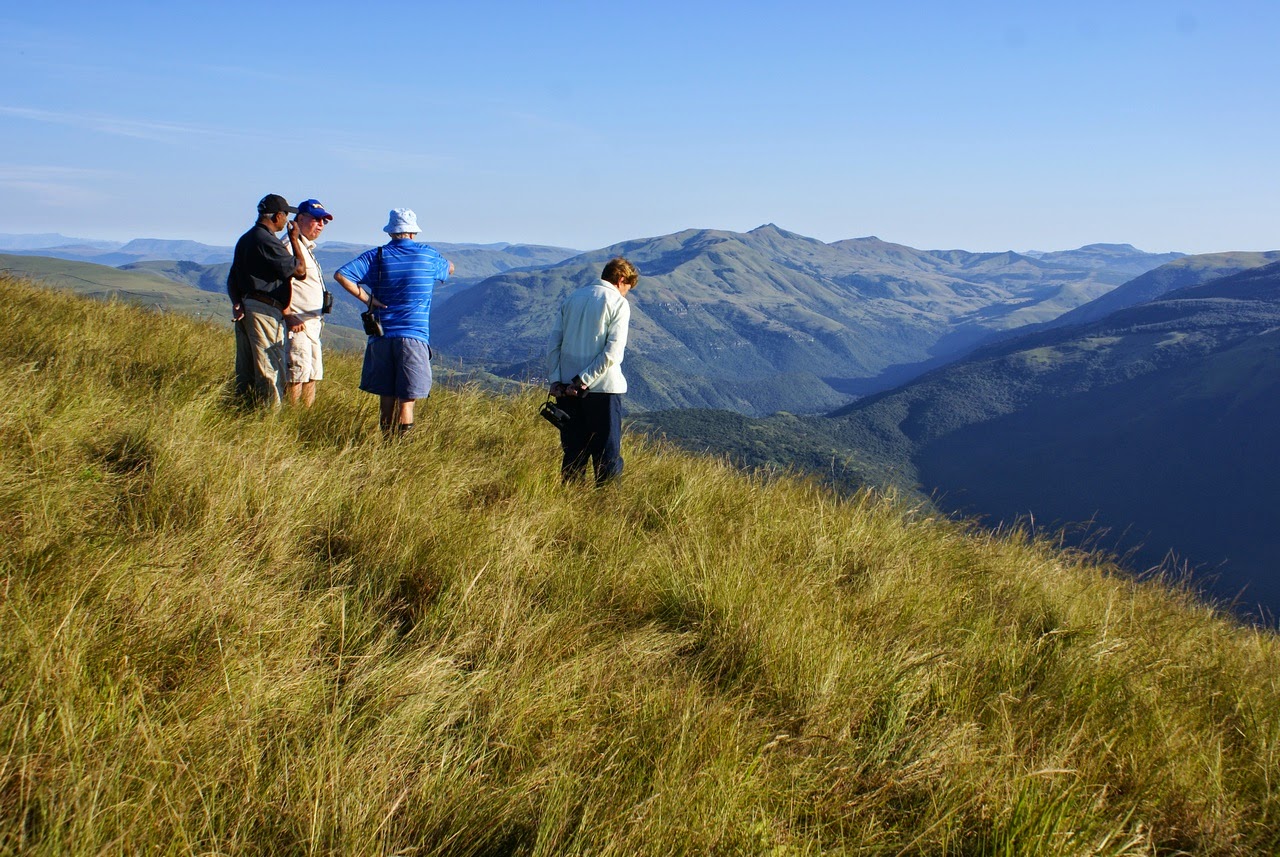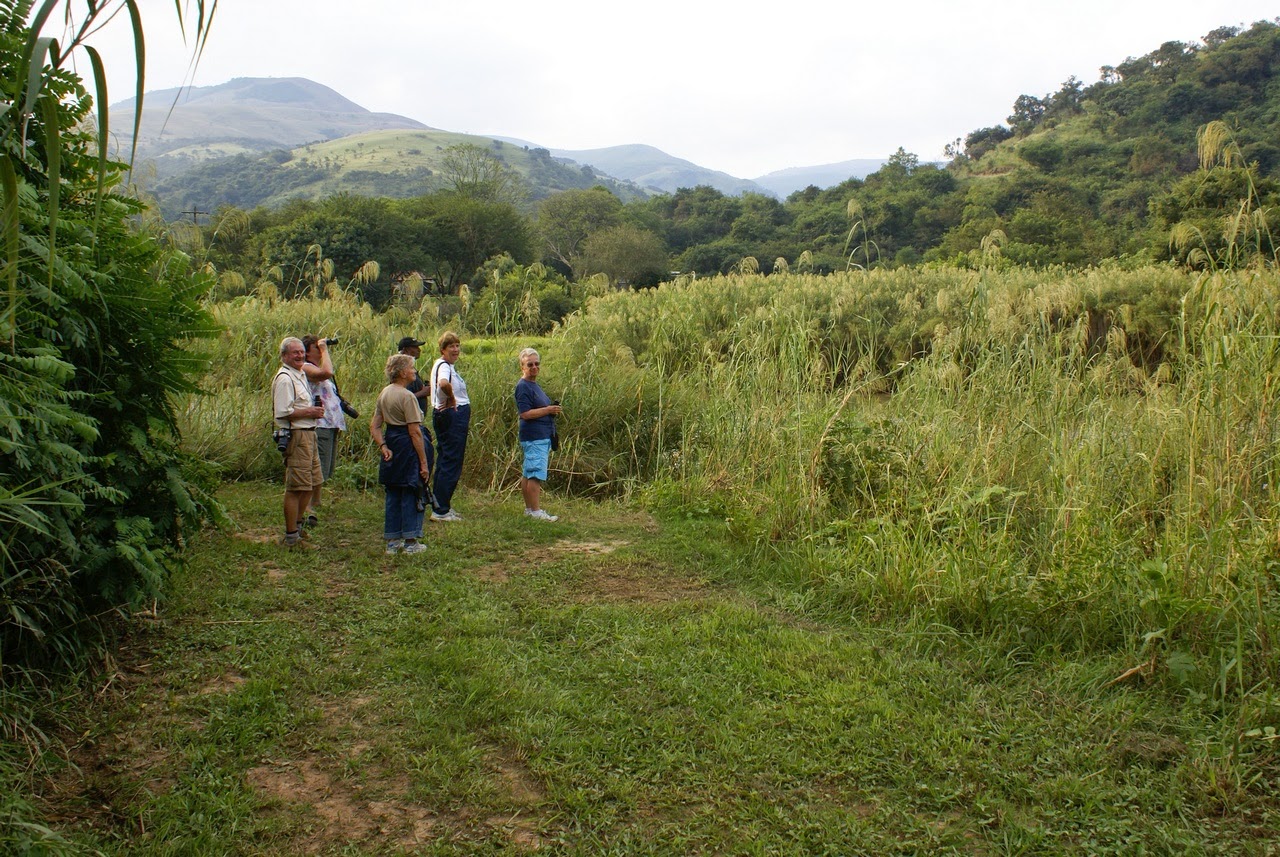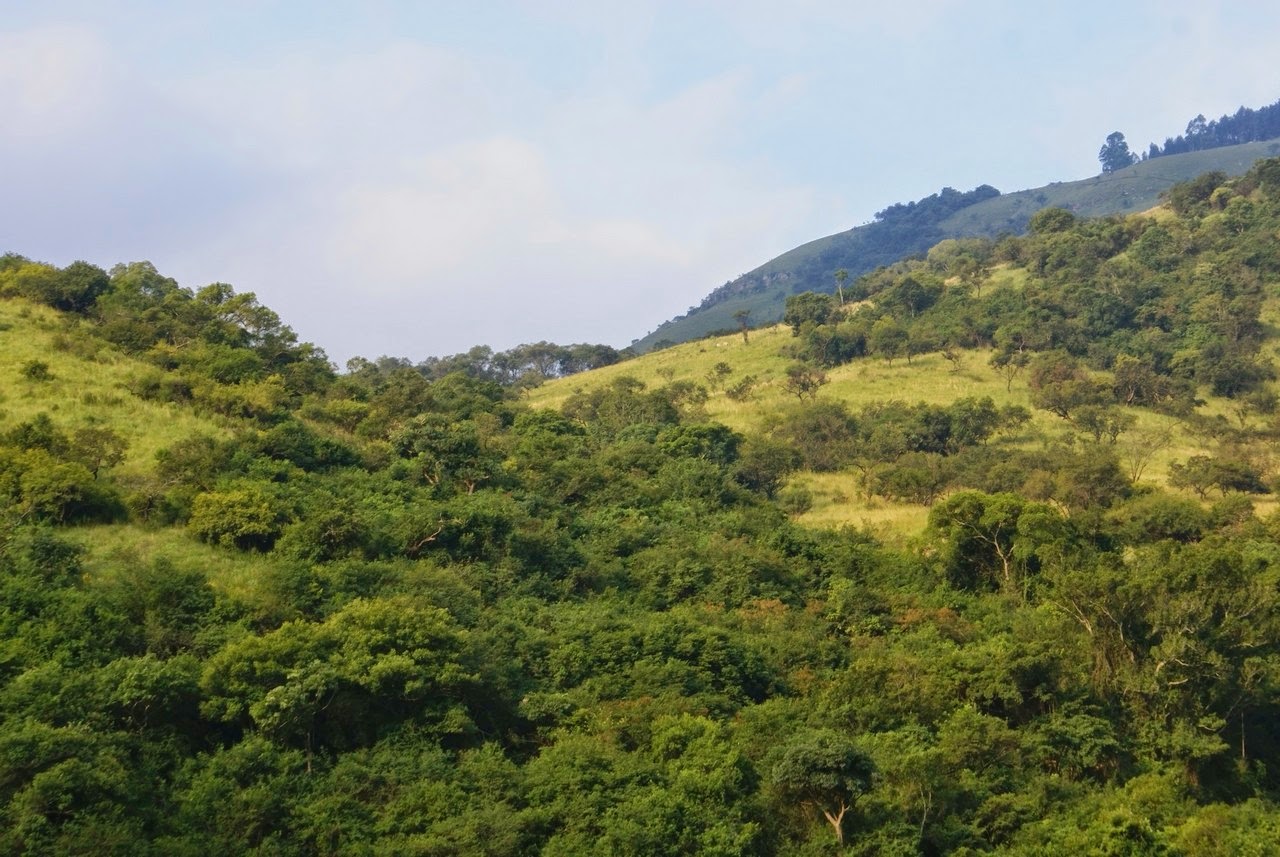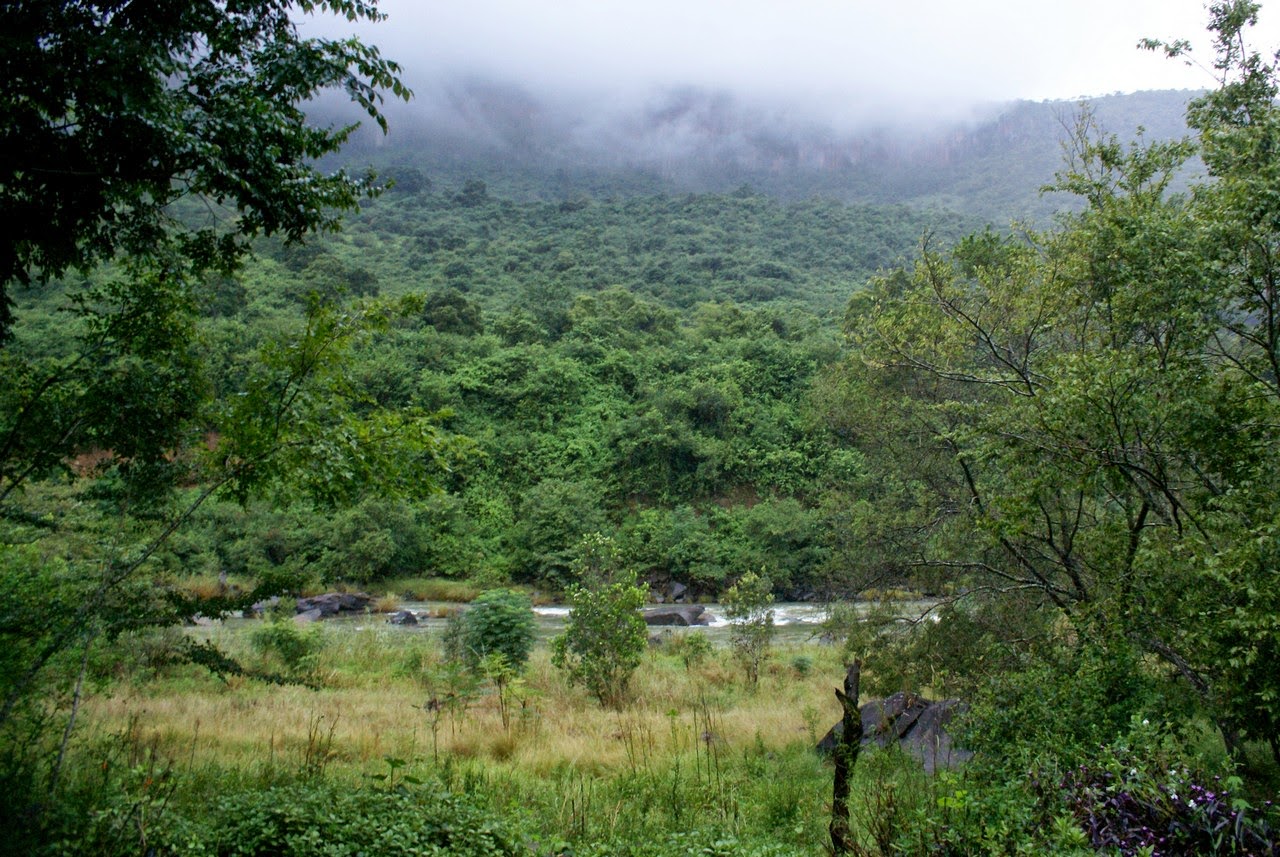Text and photos by Andy Ruffle (unless otherwise credited)
Attendees: Doug & Angie Butcher; Stan & Val Culley; Stanley & Asothie Gengan; Margaret Jones, Cathy Lee, Andy Ruffle, Irma Smook, Bob van Rooyen, Barrie Willis & Sue Hansbury. (13 attendees).
Monday 24th March
Well there was absolutely no doubt that we had stumbled upon a little gem when we arrived at this delightful reserve. Access down the pass to the valley was a little hairy at times, but it was certainly worth it.
The accommodation was perfect and to top it all, Irma and I were kindly upgraded from the bunk house to a basic chalet.
 |
| One of the basic chalets |
 |
| and this was the view from the basic chalet!! |
Once everyone had settled in to their respective chalets, we took a short walk to find our bearings.
The braai was then lit and the evening faded in to a haze.
Tuesday 25th March
 |
| (Photo Doug Butcher) |
Well rested, we were all up for an early morning walk through the camp site. The bush was alive and we soon started notching up a healthy bird list. Violet-backed Starlings gave us a nice show and an African Emerald Cuckoo could be heard calling in the distance.
In the afternoon we headed out on another walk which turned out to be slightly more adventurous than in the morning. The trail (or should I say Barrie) took us along the hillside and seemed to go up and up, with no prospect of it descending again.
 |
| a bit of a hike on this trail, but well worth the views |
 |
| the tricky part, going back down |
 |
| and safely back on terra firma |
 |
| what a backdrop as the sun began to set |
Wednesday 26th March
 |
The vulture restaurant is behind us marked by a beacon
(Photo Doug Butcher) |
Wednesday morning we arranged to drive up to the grasslands which form the upper part of the Highover property. Here we hoped to find buttonquail for Barrie and also Blue Swallow if it was still around.
As we parked our cars, we noticed a rather pungent smell, which to me was very familiar - dead animal. We were right next to an apparent vulture restaurant.
 |
| searching for the grassland specials |
 |
Mkomazi River Valley
(Photo Doug Butcher) |
Scouring the pristine grasslands proved fruitless for the buttonquail and African Grass-Owl, the grass probably being too short for the latter.
LBJ's were a plenty, giving us brief views and then darting for cover. Wailing Cisticola and Neddicky were the only two we could positively identify.
Hirundines were in full force also. White-rumped Swift, African Black Swift, Rock Martin, Alpine Swift, Black Saw-wing and Barn Swallow all being seen.
We weren't to be disappointed by the Blue Swallows either, with atleast three individuals seen swooping through the ravines.
 |
The wildlife went to Andy's head.
Here he is sporting a Springbok skull.
(Photo Doug Butcher) |
The views from the grasslands was absolutely stunning. Great debate was had, trying to work out where our camp was. It was only when we returned back to the main reserve that we realised it was directly under where we had been standing looking out.
 |
| The rest camp is located directly below this cliff edge |
Back at Highover, some of us decided to take a look at the Lodge situated near the reception. The start of a trail was noticed here, so we couldn't resist checking it out.
Although we didn't get far due to the increasing heat of the day, the spectacle of butterflies on this walk was amazing. At one point you felt like you had died and gone to heaven.....there were so many butterflies flying around.
 |
| two male Dusky Acraea having a bit of a dual |
In the afternoon, we took a walk along the river and the SAPPI Tree Trail.
 |
| alongside the river |
 |
| scanning the adjacent hillsides |
 |
| Zebra and Wildebeest on the far hills - honestly they are there |
 |
| The Mkomazi River |
Thursday 27th March
So far we had been blessed with glorious weather, but as morning broke, things were about to change.
 |
| low cloud with rain, shrouds the valley |
Low cloud and rain had set in and it didn't look as though it was going anywhere. Our plans for the morning were therefore put on hold.
But for every cloud there is a silver lining and the group were treated to a charming display by three beautiful butterflies....................well..........
 |
| can they really be angels? |
Luckily, by early afternoon conditions had improved for us to do a walk. Once again we headed through the camping area to a lovely vantage point by the river.
 |
| Stan is looking for an elusive Terrestrial Brownbul |
 |
| Mkomazi River from the camping site |
 |
| and so ends another trip away |
 |
farewell Jane
(Photo Doug Butcher) |
 |
| (Photo Doug Butcher) |
 |
| (Photo Doug Butcher) |
Friday 28th March
Another wonderful trip away came to an end. We had some good birding in a gem of a setting.
A must for a return trip we think.
Highover website: http://www.highover.co.za/index.htm
Birds recorded: (Mon afternoon) Black-headed Heron, Green Wood-Hoopoe, Long-crested Eagle, Amur Falcon, Cape Glossy Starling, Southern Black Flycatcher, Cape Wagtail, Jackal Buzzard, Cape Crow, Mountain Wagtail, (Tuesday) Black-headed Oriole, Yellow-breasted Apalis, Hamerkop, African Dusky Flycatcher, African Hoopoe, Cape Batis, Southern Black Tit, Dark-capped Bulbul, Village Weaver, Black-shouldered Kite, African Paradise-Flycatcher, Cape White-eye, Hadeda Ibis, African Sacred Ibis, Crowned Hornbill, Egyptian Goose, Olive Thrush, Brown-hooded Kingfisher, Natal Spurfowl, Red-capped Robin-Chat, Green-backed Camaroptera, Sombre Greenbul, Bar-throated Apalis, Southern Boubou, Golden-tailed Woodpecker, Cape Turtle-Dove, Red-eyed Dove, African Emerald Cuckoo, Violet-backed Starling, Kurrichane Thrush, Yellow-fronted Canary, Ashy Flycatcher, Red-throated Wryneck, Black-collared Barbet, Terrestrial Brownbul, Dark-backed Weaver, Black Cuckooshrike, Forest Canary, Fork-tailed Drongo, Spectacled Weaver, African Pied Wagtail, Black-backed Puffback, Cardinal Woodpecker, Knysna Turaco, African Olive-Pigeon, Red-chested Cuckoo, African Fish-Eagle, Spotted Eagle-Owl, (Wednesday) African Firefinch, African Stonechat, Common Waxbill, Red-winged Starling, Rock Martin, Red-fronted Tinkerbird, Amethyst Sunbird, Wailing Cisticola, Blue Swallow, Speckled Pigeon, Black Saw-wing, Rock Kestrel, Alpine Swift, Barn Swallow, Neddicky, White-rumped Swift, Common Fiscal, White-necked Raven, African Black Swift, Cape Longclaw, African Harrier-Hawk, Tawny-flanked Prinia, Collared Sunbird, White-browed Scrub-Robin, Olive Bush-Shrike, Black-crowned Tchagra, Giant Kingfisher, Thick-billed Weaver, Grey-headed Bush-Shrike, (Thursday) White-breasted Cormorant, Speckled Mousebird, African Crowned Eagle, Wahlberg's Eagle, Grey Cuckooshrike, Olive Sunbird, Emerald-spotted Wood-Dove. (94 species).






















































